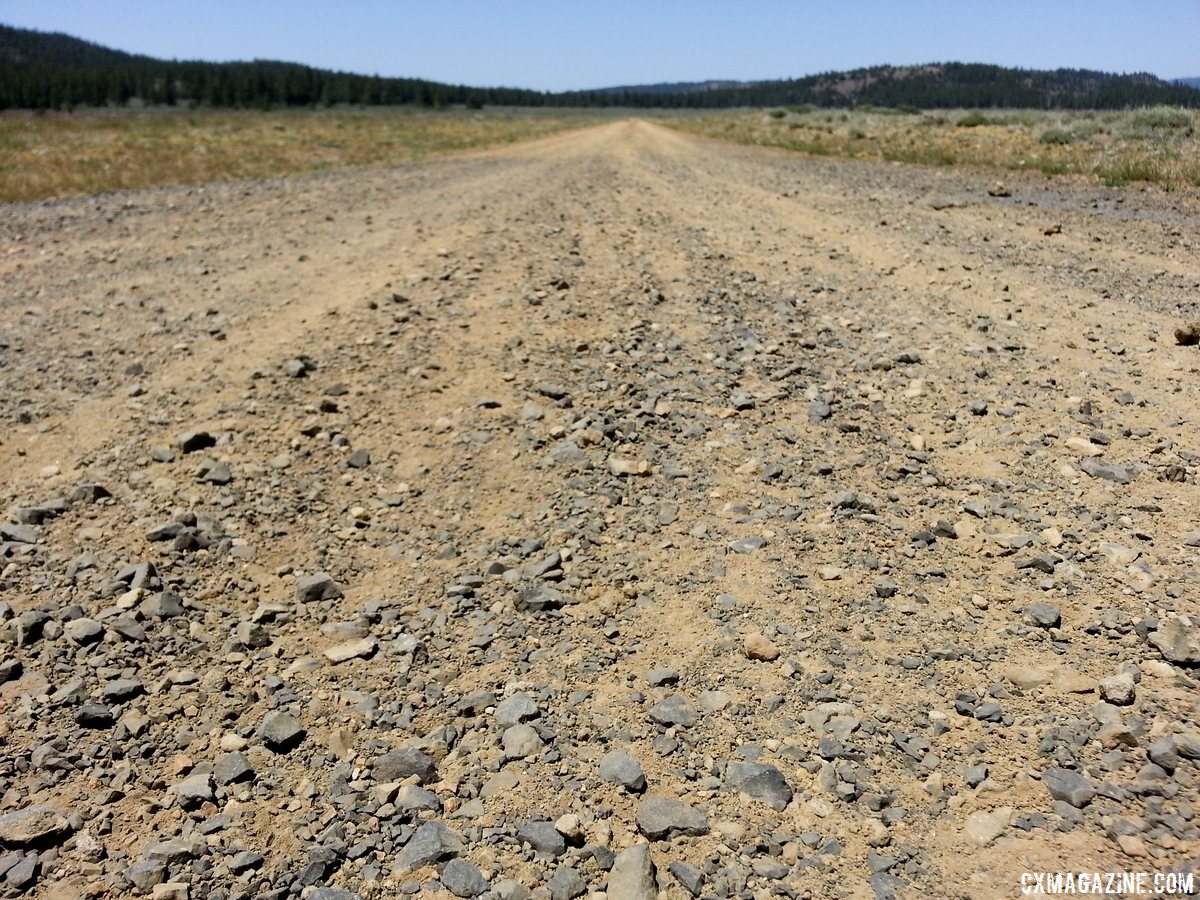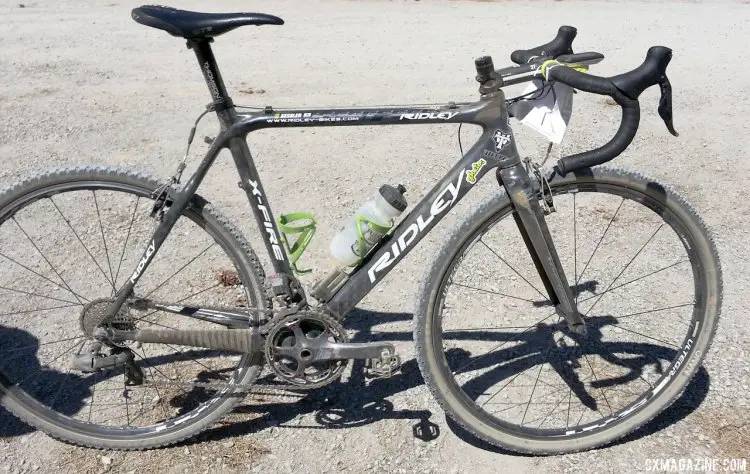After its Fat Bike National Championships won by Ned Overend and Amanda Miller was a resounding success, USA Cycling is entering the other fastest-growing segment of cycling in 2016 by organizing and regulating the exploding segment of gravel races and bikes.

2014 Lost and Found gravel race included dirt, gravel, pavement and a bit of sand. Will the event and course conditions pass the new USA Cycling standards? © Cyclocross Magazine
“The gravel segment is the Wild West of bike racing, and it really needs us right now,” said USA Cycling’s CEO, Steve Johnson. “Promoters and bike companies throw around the term ‘gravel’ loosely, racers don’t know what to expect when they see such a term, and there’s no formal regulation on equipment, categories, call-ups or upgrades. Too many people are showing up to events, thinking they can just use standard cyclocross equipment, which is often inappropriate, and sometimes downright dangerous. We’re going to change that in 2016.”
Johnson references the growing, often unsanctioned endurance gravel events like Michigan’s Barry Roubaix and California’s Lost and Found that are popping up everywhere and drawing hundreds, if not thousands, of participants as a sign that they must act swiftly before it’s too late and control the unheralded growth in this new discipline.
The governing body is proposing a sanctioned national calendar of events as well as equipment regulations starting in 2016, as follows:
Defining Gravel
While dictionary.com defines gravel as “small stones and pebbles, or a mixture of these with sand,” USA Cycling plans to get more specific, with the goal of making events safer to help grow the sport. The governing body will define gravel as:
- No singletrack is allowed
- Stones and pebbles may not be larger than 1cm in diameter
- No section of sand can be more than 4cm deep
- Dirt roads without visible gravel may only constitute a maximum of 10% of the course
No word on how USA Cycling plans to inspect race courses, as many are more than 100 miles long, but Johnson suggested a reporting system may be put in place for gravel racers to report unpredictable course conditions or terrain. “Gravel racing is not adventure racing, or jungle cross. We’ve heard from our members and the current wide variety in course conditions and terrain at these types of events is problematic.”
Regulating Gravel Bikes
“Gravel racing is just in its infancy, we’re learning as we go, and have to evolve quickly. It’s not like people did this type of cycling thirty years ago.”
Johnson said that USA Cycling worked closely with industry representatives to ensure that the new gravel discipline was aligned with the industry’s production capability and addressed its concerns.
“We have to look out for the riders,” Johnson explained. “While many think a cyclocross bike, or worse yet, a vintage road bike works well for gravel racing, they were not designed in terms of geometry and tubing to handle such events.” Johnson maintains that the modern-day cyclocross bike, while built to handle the rough terrain and stress of a cyclocross race, is ill-suited for events longer than an hour and courses that typically have limited turning, and can be dangerous in multi-hour events when riders are fatigued.
Johnson said USA Cycling’s pending regulations will create safer racing, and will reduce the number of people stressing out in the garage, trying to assemble a Frankenbike for their local gravel event. “Gravel racing is just in its infancy, we’re learning as we go, and have to evolve quickly,” said Johnson. “It’s not like people did this type of cycling thirty years ago.”
The upcoming regulations on equipment are:
- The frame’s bottom bracket drop must be 7.0 cm or more
- Frames must have at least two bottle mounts
- Wheel size must be 700c only. 27.5” (650b), fat bike, 26″, 29er plus and vintage 27” wheels are not allowed.
- Tires must be wider than 38c or narrower than 30c. (No cyclocross tires)
- Fender and rack mounts are mandatory
- Starting in 2016, National Gravel Calendar racers’ frames must be certified
The governing body was contemplating a maximum head tube angle restriction, but realized one maximum angle couldn’t be applied to all frame sizes, and did not want to complicate bike choice for its members.
The tire width requirements, on paper, seem odd, but may be a nod to the industry’s two different approaches to gravel tires, with companies like Challenge and Panaracer offering 28c and 30c gravel tires, while other companies like WTB, Clement and Vee Tires are offering high volume, 40c options. But it seems like it goes out of its way to exclude cyclocrossers.
“If gravel continues to explode, we may split the discipline into two specialties for each tire size that we’re calling internally ‘gravel speed’ and ‘gravel endurance,'” Johnson explained.
In what undoubtedly will be a controversial decision, USA Cycling, piggybacking on the successful UCI frame approval sticker program, will launch a similar program for gravel bikes.

Jared Kessler won the Lost and Found on a pretty standard Ridley X-Fire cyclocross bike, but USA Cycling aims to prevent such potentially dangerous choices. © Cyclocross Magazine
While on the surface, such regulation of a fast-growing discipline appears to be heavy-handed, Johnson justified the decision as a long-term plan to help grow the sport. Although we at Cyclocross Magazine are as guilty as anyone in pointing out the similarities between old road bikes and new gravel bikes (by highlighting the fact that only a half degree in head tube angle separates the geometry of the excellent Raleigh Tamland gravel bike from an 80s Nishiki Sport road bike), USA Cycling believes such messages are confusing at best. “Older steel bikes might have fat tire clearance and fender mounts, but the centerpull brakes, threaded bottom brackets and small diameter tubing won’t cut it when you’re 50 miles from civilization,” Johnson maintains, giving a nod towards oversize tubing, PF30, and hydraulic disc brakes.
The industry seems to support the move, with dozens of gravel-oriented options already on the market, including the Niner RLT and Foundry Overland, as well as a handful of custom builders’ offerings.
Shimano recently announced a new Tiagra group, and says the group was built with the gravel cyclist and the new regulations in mind. Notably absent from the group is a 28.6 mm front derailleur clamp option—the size required by most older, non-oversized steel bikes.
National Gravel Series Planned
USA Cycling plans to organize a national series of sanctioned events. “It’s our hope that the biggest events will sanction with us and join the series,” Johnson said. “But if they don’t, we’re confident, based on our experience smoothly running National Championships and World Championships, that we can work with new promoters to execute top-level events.”
Plans for a ranking system that determines call-ups, as well as a new USA Cycling racing license category are already being formed. “We’ll honor road and XC categories, but downhill and cyclocross racers will be downgraded one category due to their shorter events,” said Johnson.
There was no mention of a gravel National Championships during our interview, but given that over 70 racers attended the inaugural Fat Bike National Championships, we expect USA Cycling’s next step would be to hold a championship race and add its expertise and liability insurance to this movement. Stay tuned as we bring you more details on this breaking story.
Think this is a good move by USA Cycling? Tell us what you think below.
Note: This story was published on April 1, 2015. Check with USA Cycling and your local gravel promoter for the most up-to-date rules and regulations on gravel racing.


























